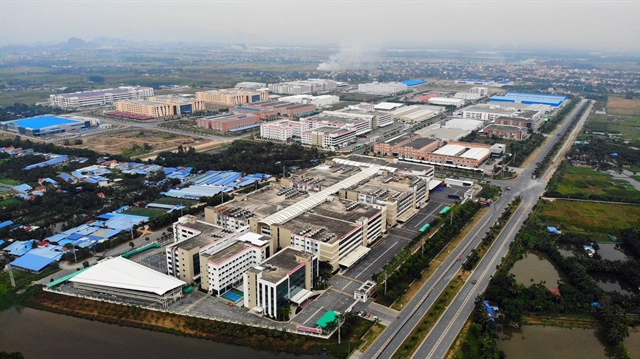The Impact of the Semiconductor Industry on Vietnam’s Industrial Real Estate Market

Caption: A view of Vietnam-Singapore Industry Park Hải Phòng. Việt Nam’s industrial land area exceeds 38,000 hectares across 203 operational industrial zones, reflecting a five per cent increase year-on-year.
The semiconductor industry is pivotal in propelling the growth of Vietnam’s industrial real estate market, driven by robust investments and supportive government policies. In 2024, Vietnam’s total registered Foreign Direct Investment (FDI) reached approximately US$38.2 billion, marking a significant influx into high-value-added sectors like semiconductors, energy, and electronics manufacturing. This nascent growth paints a promising landscape for the country, encouraging a wave of development in industrial zones.
Strategic Position in Global Supply Chains
Vietnam’s advantageous location in the global supply chain enhances its appeal as a destination for major tech corporations. The strategic positioning, especially in relation to the Silicon Valley of China (Guangzhou, Shenzhen, Dongguan), facilitates supply chain diversification. This allows companies to adopt the ‘China +1’ strategy, thus reducing dependence on China while mitigating geopolitical risks.
Thomas Rooney, associate director of Industrial Services at Savills Hanoi, emphasizes that the surge in high-tech projects and R&D centers is fostering a robust demand for infrastructure, ready-built factories, and overall growth in the industrial real estate market. According to the Savills Industrial Insider Report 2024, Vietnam boasts over 38,200 hectares of industrial land across 203 operational industrial zones, representing a remarkable five percent year-on-year increase.
Infrastructure Developments and Foreign Investments
Robust infrastructure is integral to Vietnam’s attractiveness for foreign investors. The government allocates seven percent of GDP to key projects such as the North-South expressway, Long Thành International Airport, and deep-water ports like Cái Mép in Bà Rịa Vũng Tàu. These projects create direct connections to Europe, the Americas, and Southeast Asia, further positioning Vietnam as a central hub for international trade.
Moreover, with a large and skilled workforce, coupled with effective policies supporting high-tech projects, Vietnam is steadily evolving into a high-tech manufacturing powerhouse. This combination of factors offers a compelling case for international investors looking for lucrative opportunities in the region.
NVIDIA’s Influence on Semiconductor Development
The recent collaboration between the Vietnamese government and NVIDIA, a leader in AI and semiconductors, is a significant milestone for the nation. NVIDIA’s establishment of an R&D center in Vietnam promises to bolster the demand for developing high-tech zones, increase industrial real estate value, and attract further investments from major tech players. Rooney notes that this will elevate industrial zones, expanding opportunities for modern infrastructure and complementary industries.
Vietnam’s potential in the semiconductor sector is further highlighted by its rich resources of rare earth materials, ranking second globally only to China. These materials are crucial for electronics and semiconductor chip manufacturing, presenting significant prospects for sustainable growth.
Government Initiatives and Workforce Development
The Vietnamese government is proactive in implementing supportive policies for the semiconductor industry. Notably, on September 21, 2024, the Prime Minister approved a program to develop human resources for the semiconductor sector, aiming to train at least 50,000 graduates with a university degree or higher by 2030.
Additionally, the National Assembly has recognized the need for a fund to support high-tech project investors, ensuring a stable investment environment, boosting competitiveness, and attracting strategic partners. The government also endorsed the National Power Development Plan VIII to guarantee a steady electricity supply for investment projects, focusing on sustainable energy solutions.
Key Industrial Parks and Future Developments
Local authorities are committed to providing sufficient electricity and water to meet the burgeoning needs of semiconductor producers. Major industrial parks like those in Bắc Ninh are tailored to the semiconductor industry’s rigorous standards, featuring advanced infrastructure and robust fire safety systems, all within easy reach of international transport hubs.
The Thuận Thành Industrial Park in Bắc Ninh exemplifies the strategic development of sustainable and environmentally friendly industrial spaces designed to attract high-tech industries. These projects reflect a shift towards green models, ensuring that both new and existing parks are equipped to accommodate the demands of domestic and international investors.
Rooney notes that over the next few years, the Vietnam-Singapore Industry Park (VSIP) will undergo significant upgrades, starting with the project in Long An Province, marking a new chapter in Vietnam’s industrial landscape.
Conclusion
As Vietnam continues to enhance its industrial real estate market, the semiconductor industry stands at the forefront, promising continued growth and opportunity. The government’s proactive policies and local efforts to create an attractive investment environment make Vietnam a notable player in the global tech landscape.